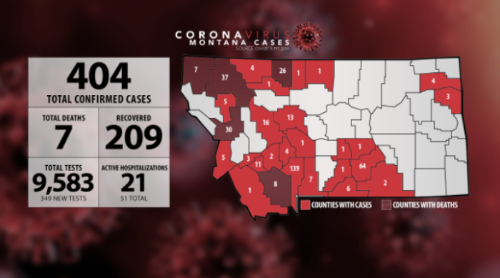Pesticide News - April 15, 2020
Antimicrobials and Respirators: COVID-19
Cecil Tharp, MSU Pesticide Education Specialist
Montana residents are contending with difficult times due to the spread of the COVID-19 virus, otherwise known as the “Corona Virus”. As of April 15th there are 404 confirmed cases, 51 current and past hospitalizations and 7 deaths (Figure 1). Due to the high infection and mortality rate, Governor Bullock issued a “Stay at Home” order for non-essential businesses until, at least April 24th. This news release will discuss the N95 respirator shortage, available antimicrobials, and correct use of respirators to protect against this virus.

Figure 1. COVID-19 cases in Montana as of April 15th, 2020 (Posted at KRTV news; KRTV.com.)
Shortage of N95 respirators
Pesticide applicators planning on using pesticides requiring N95 particulate respirators should be aware that we are under a nation-wide shortage due to the COVID-19 situation. This shortage will continue for an undetermined time period. Many experts believe this could last well into the season, or longer. Applicators planning to use paraquat or atrazine products, or a few other select pesticide formulations (i.e. dry formulations, some insecticides/fungicides/rodenticides) must follow the product label requirements, or consider alternative pesticide formulations not requiring an N95 respirator. See the latest Bloomberg publication for more details regarding the shortage. Due to the shortage of medical personal protective equipment applicators are urged to find pesticide alternatives that don’t require N95 respirators if possible. Contact an MSU County Extension Agent or MSU Agricultural Specialists for alternative pesticide chemistries that don’t require an N95 respirator.
To use the N95 respirator on agricultural crops you still must pass a fitness evaluation, a fit test, and perform a proper seal test prior to application. If applying to a pesticide site see the WPS respirator requirements.
Antimicrobials that are effective against COVID-19
Pesticides that fight microbes are generally termed “antimicrobials”. When used to protect human health they can further be classified as sanitizers, disinfectants, virucides and sterilants. To maintain virus-free surfaces use a disinfectant or a virucide, however in a hospital, generally more toxic sterilants are used. About 275 active ingredients are found in antimicrobials, most of which are considered pesticides, and must have an EPA-approved label (a few sanitizers are regulated by the Food and Drug Administration and considered a drug not a pesticide, and registered for use on skin). See the Environmental Protection Agency’s (EPA) Disinfectants for use against COVID-19 webpage that contains a list of federally registered pesticides that are labeled for use against COVID-19. Keep in mind some products are federally registered but not registered in Montana. If seeking products registered only in Montana see the Montana specific COVID-19 registration webpage. Always follow the pesticide product label.
Use of N95 respirators and other materials during COVID-19
Individuals can reduce the chance of non-airborne infection by washing hands regularly while not touching their face to limit transmission from contaminated objects. Six foot distancing requirements will minimize airborne transmission; however, respirators are also recommended for medical staff, those caring for others that are sickened, and now individuals traveling to many public places (i.e. grocery store). Individuals may use self-made masks, scarfs and bandannas, however their effectiveness may vary according to material and design. The N95 respirator is effective at reducing transmission to others if infected, and if worn properly, may reduce transmission from others who may be sickened. It is critical that medical staff have access to N95 respirators during this shortage, however, many individuals may have one or a few N95 respirators that they could use. Keep in mind the following if you plan on using the N95 respirator:
- Re-use of N95 respirators historically is not recommended; however, due to the shortage of N95 respirators users may be forced to re-use respirators. Respirators can be used multiple times, however individuals must follow a hygienic approach as contamination of the exterior components of the respirator should be assumed. Never touch the inside of the N95 mask and store in a paper bag.
- Studies have shown that N95 respirators may be sterilized by placing in an oven at 158 degrees F for 60 minutes. Studies have shown this is effective in eliminating contamination, however mask fit may be compromised if sterilized over 3 times. Always use a wooden cloth pin to hang N95 respirators as metal racks in oven will often burn the respirator. See news release detailing study and comparing various methods.
- All individuals using an N95 should at least conduct a quick seal test of the N95 respirator. Respirators should be checked for proper fit prior to use. Follow the Occupational Safety Health Video for conducting a proper seal test prior to use. Facial hair often will compromise the effectiveness of N95 respirators.
Recommendations may change over time in response to federal and state orders. This article does not promote hoarding of N95 respirators in any case, and is only outlining strategies for those that already have access to N95 respirators.
For more information
See the EPA Coronavirus Webpage for a variety of resources pertaining to COVID-19. Contact an MSU Extension Agent for alternative pesticide chemistries, or contact the MSU PEP (Cecil Tharp, 406-994-5067, [email protected]) for questions regarding the Montana Private Applicator Program. For more information regarding the proper use of respirators for agricultural production including seal tests, fitness evaluations and fit testing see the Pesticide Education Research Collaborative “Worker Protection Standard Respiratory Protection Guide”.
